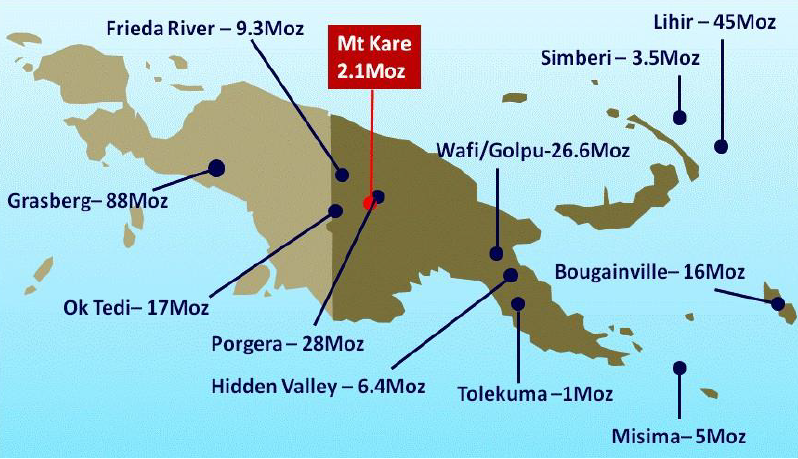卡雷山金矿是一个世界级金矿,位于巴布亚新几内亚波尔盖拉(Porgera)金矿西南15公里处,海拔2600米~3225米。

卡雷金矿为巴布亚新几内亚众多金矿之一
The Mt Kare deposit is a multi million ounce gold equivalent resource located approximately 15 kms south west of the Porgera Mine (28 million oz) in the Highlands of Papua New Guinea at an elevation ranging from 2,600 m to 3,225 m asl (access by helicopter only).
Mt Kare is characterized by large areas of strongly altered sedimentary and intrusive rocks which host anomalous precious metals and base metals. Mineralization (genetically related to a mafic intrusive complex) is localized along fractured, brecciated and altered margins rarely extending into the intrusives. Initial mesothermal carbonate-base metal gold mineralization is locally overprinted by a later telescoped epithermal quartz-gold-silver hydrothermal mineralization. The Kare intrusive structure, similar to the Porgera, is located on the NE-trending Porgera Transfer Structure. Carbonate base metal-gold mineralization is centered on these high level mafic intrusives and breccia zones within the transfer structure.
Mineralized zones on the property includes the Western Roscoelite Zone, the Lower Maratani area (approximately 1 km south of, along strike of the trend of the Western Roscoelite Zone), the Black Zone and the Central Zone.
Six high priority targets include the Black Zone North/Realgar, Black Zone South, Middle Maratani, Pinuni Creek, Orosa and C9 zone areas.In addition, two or three priority geophysical targets will also be tested during this drilling program prior to the next scheduled field break.
Western Roscoelite Zone
Low temperature mineralization at Mt. Kare predominantly occurs in the Western Roscoelite Zone which contains a surface geochemical anomaly with a strike length in the order of 1,500m. The mineralization in this zone is characterized by varying degrees of brecciation, bleaching and sulphides with occasional coarse free gold and massive pyrite veining. Gold mineralization is associated with pyrite and base metal sulphides with higher grade intervals associated with quartz and/or roscoelite. Mineralization is hosted by a range of meta-sediments but more competent psammitic (sandstone) units are the main locus of mineralization where a brittle response to deformation has produced a greater intensity of open spaces for mineralizing solutions.
Central zone
The Central Zone of mineralization is a generally sub-horizontal to gently dipping lode within the saprolite profile which extends to approximately 50m below surface. Tropical weathering and associated saprolite development have destroyed original textures. Artisan mining has focused on the topographic toe of the Central Zone. The Central Zone dimensions are approximately 700m by 300m in area with the northern margin truncated by a sub-vertical structure known as the Central Fault. Mineralization in the Central Zone has similar character to the Western Roscoelite Zone but is interpreted to have a different global strike orientation and is of lower tenor.
Black Zone
The Black Zone parallels the Western Rosoelite Zone but is some 600m to the east. The zone derives it name from the pervasive strong manganese alteration. The Black Zone mineralization occurs along a brecciated and possibly faulted lithological contact between sedimentary rocks with the contact dipping subvertically to steep westerly. High grade mineralization is associated with narrow mafic dykes but there are no large intrusive bodies identified in surface mapping or drilling.
C9 Zone
The C9 Zone is below the Central Zone. The zone derives its name from the discovery hole of the zone which at the time was know as C9 (the hole is now designated MK9). The mineralization in C9 is hosted by brecciated and sheared rocks which are associated with locally steeply dipping shears and dykes. The highest tenor part of the zone is associated with a large mafic dyke that defines the northern boundary of the Black Zone.
Prefeasibility Study Results (Oct/12)
. Forecast total production is 1 million ounces gold and 8 million ounces silver over 8 years.
. This scenario generates a Cumulative Revenue of US$2 Billion with Operating Costs of US$ 800 million generating a pre-tax internal rate of return of 28% and payback period of 4 years based on US$1650/oz gold price.
. The estimated establishment capital cost to cover mine construction to first production is US$218 million, which includes the processing plant (US$96 million), a power plant (US$15 million), and associated infrastructure, including a tailings storage facility (TSF).
金矿化与镁铁质基性岩侵入有关。矿区有大面积蚀变。早期矿化为中温热液碳酸盐矿物-贱金属-金组合,晚期叠加低温热液石英-金-银矿化。
卡雷山金矿化特征与波尔盖拉金矿相似。矿区区域性断裂为北东向的波尔盖拉断裂,控制基性岩体侵入。
卡雷山金矿由四个矿带组成。包括西部的罗斯科里特带(Roscoelite)、下马拉塔尼(Maratani)带、布拉克(Black)带和中心(Central)带。